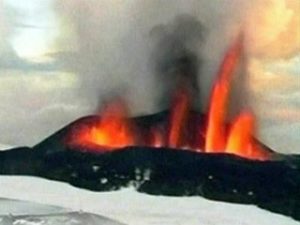I had never heard of it. I still struggle to say it. However, on Friday, Iceland’s Eyjafjallajökull volcano taught some valuable lessons.
The eruption of Eyjafjallajökull (pronounced ay-yah-FYAH-plah-yer-kuh-duhl, according to the Associated Press) began on Wednesday, and resulted in the cancellation of more than 63,000 flights by Sunday. One of them was mine.
 The economic ripples are quickly translating into supply chain realities. They will fill the press for weeks. They will become the new stories for the supply chain risk management text books; but before this happens, I want to share. In the middle of this chaos, I had several Eureka moments. Here I tell my story, what I learned, and why I think that it is important.
The economic ripples are quickly translating into supply chain realities. They will fill the press for weeks. They will become the new stories for the supply chain risk management text books; but before this happens, I want to share. In the middle of this chaos, I had several Eureka moments. Here I tell my story, what I learned, and why I think that it is important.
-Volatility versus Surprise: While most of the supply chain risk management plans focus on the management of the supply chain through periods of volatility, there is very little writing on navigating a supply chain through a period of surprise. Supply chain risk in a period of surprise is VERY different than management of the supply chain through volatility.
This was clearly a surprise. Unlike a hurricane, there was no early warning system, no pre-planned drills, or carefully crafted procedures. The reason? Who would ever have thought that an Iceland volcano would have such a profound affect?
When a surprise happens, the need for the immediacy of data increases. In this case, I found that twitter was my NEW best friend. This was my Eureka moment.
-Immediacy of Information. As I descended into the din of chaos at JFK airport in New York, I was able to get real-time pictures, updates, and recommendations. My Tweetdeck was quickly broadcasting messages on hashtags #ashtag and #EAU. Both tags were actively tweeting information from around the world, from people that I did not know, and with incredible accuracy.
I knew that my flight to Milan would not fly two hours ahead of the notification from the Delta medallion service desk. As the Milan airspace closed, I knew that the Barcelona airport might be a possibility and I had the right flights to ask for. The information was both more accurate and immediate then what I could get on the ground from customer service agents. As the day progressed, I became a BELIEVER.
Why it Matters
As a supply chain risk manager, the first step that I would take in planning for a surprise is to be sure that EVERYONE understands the power of twitter. Establish the hash tags early, and empower employees to actively tweet information. Embrace social media into your field readiness plans.
I am now rescheduled to fly to Milan on Tuesday. I will consult twitter before I go to to the Delta website to check flight status. I will continue to monitor #ASHTAG for information throughout the day tomorrow, and if I get stuck in Europe, you will find me tweeting to look for a hotel. Wish me luck on getting to Europe.
Next week is sure to be a mess. I wish you luck sorting through the issues, finding out where your freight is, and how to expedite it. You may want to try twitter. Consult the #ashtag, it may hold some promise for you in the week of chaos as well.
What do you think? Any good stories to share on the use of social media to navigate this situation?






